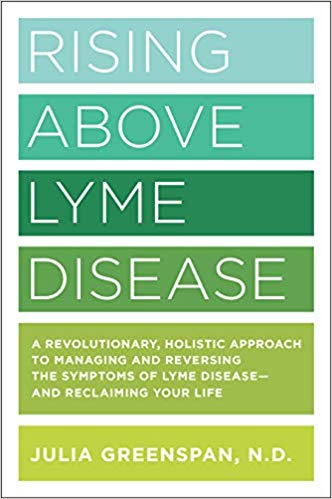“Rising Above Lyme Disease” offers guidance for patients and families

By Julia Greenspan, ND
Chronic Lyme disease and associated co-infections are creating a chronic disease juggernaut that is moving through the environment, the human body and our health care system. This diminishes quality of life and productivity while increasing medical costs.
The biggest risk factor associated with Lyme disease is the denial of treatment rather than the disease itself. Acute Lyme disease comes from the tick, but chronic Lyme disease is a man-made problem resulting from delay in diagnosis and denial of treatment.
The need for medical savvy
More than just a physical experience, Lyme disease requires a level of medical savvy that patients don’t even know they need–until they try to find treatment for a chronic condition that many others believe doesn’t exist.
Finding appropriate, compassionate care is a game with a unique set of rules for navigating the medical system and insurance coverage. And the stakes are high.
Unresolved tick-borne disease opens the door to a range of chronic health conditions that are seemingly unrelated. These can include cardiovascular effects, hormone imbalance, neurological diseases, autoimmune diseases, premature aging, and chronic pain (both emotional and physical).

This scenario happens more often than most will admit. As much press as the disease gets, people with the infection still feel that they are living in the shadows, shamed for not getting well fast enough or accused of attention-seeking behavior.
The more we understand the barriers a Lyme patient is up against, the more compassion we as a society will be able to give. And the more we will understand that it takes time to heal.
In an article titled “Suicide and Lyme and Associated Diseases,” Robert Bransfield, MD, reports a high level of suicidal ideation in Lyme disease patients.
He correlates suicide attempts with neurocognitive changes in the brain, due to increased neuroinflammation, that cause thoughts of self-harm.
Alienation
In addition, negative attitudes toward chronic Lyme disease sufferers cause patients to feel alienated. The fact is, most people who die from Lyme disease and associated co-infections die by their own hand. It’s a heavy burden to carry the disease and have to defend it at the same time.
But this does not have to be the reality. Much suffering could be eliminated if patients, families, the medical community, and government approached patients with greater compassion and inclusivity.
Suicidal ideation is nondiscriminatory—it affects those of all ages and genders. I have seen children diagnosed with tick-borne disease and pediatric autoimmune neuropsychiatric disorders associated with streptococcal infections (PANDAS) who show cutting behaviors, have thoughts of suicide, or exhibit other forms of self-harm, necessitating psychiatric care as well as aggression towards others.
Children and adults with no apparent history before contracting tick-borne disease become suicide risks. While a great deal of detail about PANDAS is beyond the scope of this article, it’s important to screen children who may be affected for streptococcal antibodies, along with testing for tick-borne disease, especially if the patient exhibits psychiatric symptoms after the onset of fever, sore throat, confirmed strep infection, or flu-like symptoms.
The stigma of Lyme disease
The stigma surrounding chronic Lyme disease creates an atmosphere in which patients feel the need to hide symptoms, which enhances stress and shame. Among the lowest emotional states, shame involves humiliation and isolation. It can bring one eventually to thoughts of self-harm just to end the suffering.
This is mostly due to prolonged pain, mental and emotional imbalance, and isolation. But these symptoms could largely be avoided if we ended the social rejection of those who have chronic Lyme disease and funded education for the general public to foster greater compassion and awareness.
Digging deep for inner strength
Tick-borne infections require patients to dig deep and learn the self-care, self-advocacy, and inner strength they will need to endure the long marathon of recovery. Those who lack self-love, have experienced trauma, or have a habit of placing their own needs lowest on the totem pole, will find that these patterns hamper recovery.
Life stressors, mental or emotional imbalances, and negative outlooks can be magnified during the treatment process. Neuroinflammation created by the presence of spirochetes in the brain intensifies old emotional wounds, fears, and traumas, which can dramatically slow the healing process.
The healing power of the mind is substantiated by science daily, and it is a power we all have access to. Integrating conventional medical methods with alternative and energetic healing makes recovery more efficient. I have spent more than a decade weaving together multiple modalities to support patients through their journey to heal from tick-borne disease as well as myself.
How do we rise above Lyme disease? We become educated about what to expect in the course of diagnosis and treatment, and we learn how to advocate for ourselves.
My hope is that my book offers a framework for understanding the diseases ticks carry, related conditions that make recovery more difficult, the sociological impact of tick-borne disease, the trauma of trying to find help, and the range of complementary treatment options.
A guide and a reference
“Rising Above Lyme Disease” is a guide for patients, family members, support groups, and others. It can serve as a reference for treatment options, symptoms, and approaches to preventing long-term complications.
I hope for this to be another piece of information among many other important books available to help support the community and arm it with more knowledge to feel empowered.
Julia Greenspan, ND, practices in Amherst, New Hampshire., with a focus on Lyme and other tick-borne diseases. She is a member of ILADS. Click here for more information about the author and her book, “Rising Above Lyme Disease.”




















We invite you to comment on our Facebook page.
Visit LymeDisease.org Facebook Page